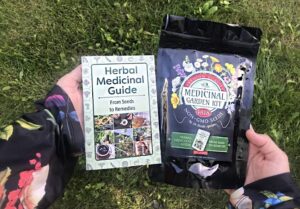Introduction: Why Medicinal Herbs Are a Must for Ohio Gardeners
What if I told you that some of the best remedies for stress, headaches, sleep problems, and even skin issues aren’t sitting on a pharmacy shelf… they’re waiting to be grown right in your backyard here in Ohio?
It sounds almost too good to be true, doesn’t it? But the reality is, people have been using medicinal herbs for centuries—long before modern pills and supplements existed. And today, more and more Ohio gardeners are rediscovering these plants not just for their beauty, but for their healing power.
Here’s the best part: you don’t need a giant farm or endless gardening experience. Whether you have a suburban backyard in Columbus, a small patio in Cleveland, or even just a few pots on your Cincinnati balcony, you can grow herbs that help with everything from better sleep to stronger immunity.
In this guide, I’ll walk you through the top medicinal herbs that thrive in Ohio’s climate, why they’re so effective, and how you can start growing them today—even if you’re a complete beginner. By the end, you’ll see how easy it is to create your own mini backyard pharmacy that saves money, builds self-reliance, and brings natural healing into your everyday life. 🌱
Understanding Ohio’s Climate for Medicinal Herbs 🌦️
Before we dive into which herbs to grow, it’s important to understand why Ohio is a great place for medicinal gardening. Your local climate plays a huge role in how well these plants thrive.
| Factor | Details (Ohio) |
|---|---|
| Climate Type | Humid Continental |
| Average Rainfall | ~40 inches/year (well-distributed) |
| Summers | Warm, 70°F – 85°F (21°C – 29°C) |
| Winters | Cold, often below freezing |
| Growing Season | About 160–180 days |
✅ What This Means for Herbs
-
Plenty of Rain → Herbs like peppermint, lemon balm, and calendula do really well.
-
Warm Summers → Great for basil, lavender, and chamomile.
-
Cold Winters → Hardy perennials like echinacea, thyme, and feverfew survive year after year.
-
Short Growing Season → Some herbs (like aloe vera) need to be grown in pots indoors during winter.
🌿 Quick Tip for Ohio Gardeners
-
Start seeds indoors in early spring (March–April).
-
Move them outside after the last frost (usually late April–May).
-
Protect potted herbs or bring them inside once temperatures drop in fall.
Ohio’s climate is versatile, which means you can grow a wide variety of medicinal herbs both outdoors and indoors. With the right care, you can enjoy fresh remedies through all four seasons.
1. Chamomile – The Relaxing Herb
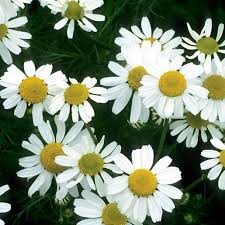
Benefits
Chamomile has been used for centuries as a natural anti-inflammatory, digestive aid, and mild sedative. It’s commonly used to:
- Soothe stress and promote sleep
- Support digestion and relieve menstrual cramps
- Reduce inflammation and minor skin irritations
(Allrecipes, PMC)
Planting & Maintenance (Ohio-Friendly)
| Step | Details |
|---|---|
| Planting | Sow in spring, after last frost; place seeds on top of moist soil (don’t cover—they need light to germinate). (RHS) |
| Soil & Light | Prefers well-draining soil and full sun, though partial afternoon shade helps in hotter spots. (Plough and Furrow, The Spruce) |
| Watering | Water regularly (~1 inch/week) while young. Once established, it’s drought-tolerant. (The Spruce) |
| Growth Timeline | Germinates in about 1–2 weeks. Full bloom arrives in 2–3 months (approx. 10–12 weeks). (reddit.com, The Spruce) |
| Maintenance | Deadhead spent blooms to encourage more flowers. Watch for pests (aphids, thrips) and treat with insecticidal soap if needed. (The Spruce) |
Easy Daily Remedy
Chamomile Tea for Calm & Relaxation
- Recipe: Steep 1–2 fresh or dried chamomile blossoms in hot water for 5–10 minutes. Enjoy before bed to support restful sleep and soothe anxiety.
- Why It Works: Chamomile’s flavonoids and essential oils (like bisabolol and apigenin) have calming, anti-inflammatory, and mild sedative effects. (Medical News Today)
Quick Summary Table
| Feature | Chamomile Highlights |
|---|---|
| Benefits | Calms stress, aids sleep, soothes digestion |
| Germination Time | 1–2 weeks |
| Full Bloom | 10–12 weeks |
| Sun Requirement | Full sun to partial shade |
| Water Needs | Water weekly at first; drought-tolerant later |
2. Lavender – The Stress-Relief Superstar
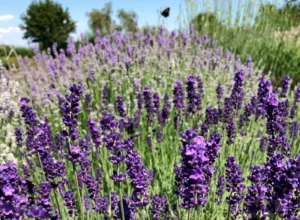
Benefits
Lavender (Lavandula angustifolia) is renowned for its anxiety-reducing and sleep-promoting effects. Studies show both oral and inhaled lavender oil can significantly reduce anxiety and improve sleep quality—sometimes nearly matching the effects of anti-anxiety medications like benzodiazepines.
- A systematic review of clinical trials found that oral lavender essential oil (like the standardized product Silexan) can reduce anxiety disorders’ symptoms. Its inhalation also shows measurable calming benefits (The Sun, Nature).
- Another review reported strong correlations between lavender oil inhalation and reduced anxiety levels in controlled studies (MDPI).
Planting & Maintenance (Ohio-Friendly)
| Step | Details |
|---|---|
| Planting Time | Plant starts after last frost, when soil warms to ≥60 °F (15 °C) (Almanac, Lavender Hill Farm). |
| Sunlight | Needs full sun—6 to 8 hours per day to thrive (Timbuk Farms & Garden Center, The Spruce). |
| Soil & Drainage | Prefers well-drained, slightly alkaline soil. Amend heavy or clay soils with sand, grit, or plant in raised beds or pots (Bonnie Plants, Southern Living). |
| Watering | Water young plants regularly. Mature lavender is drought-tolerant—avoid overwatering to prevent root rot (Southern Living, The Spruce). |
| Spacing | Space plants 12–18 inches apart for good air circulation and healthy growth (Bonnie Plants). |
| Hardiness | Hardy in USDA zones 5–9, making it suitable for much of Ohio (Lavender Hill Farm, Wikipedia). |
| Timeline | Blooms typically appear in late spring to early summer, with strong fragrance and frequent flower production (Midwest Living, Bonnie Plants). |
Easy Daily Remedy
Lavender Aromatherapy for Anxiety & Better Sleep
- Recipe: Place a few lavender flowers or a drop of pure lavender essential oil on your pillow, or use a diffuser while you sleep. Inhale deeply.
- Why It Works: Inhaled lavender oil engages the olfactory system, helping reduce physiological signs of anxiety like blood pressure and pulse rate (MDPI).
Quick Summary Table
| Feature | Lavender Highlights |
|---|---|
| Benefits | Calms anxiety, aids sleep |
| Sun Requirement | Full sun (6–8 hrs/day) |
| Water Needs | Low once established |
| Spacing | 12–18 inches apart |
| Hardiness Zones | USDA 5–9 (Ohio friendly) |
| Bloom Season | Late spring to early summer |
Lavender is both beautiful and therapeutically powerful, and with minimal effort, it can become your go-to plant for relaxation and peaceful sleep.
3. Peppermint – The Digestive and Cooling Powerhouse
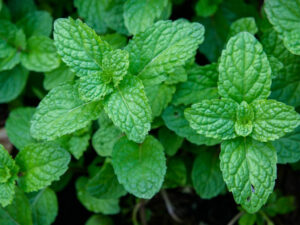
Benefits
Peppermint (Mentha × piperita) is a top choice for promoting digestive health and easing discomfort:
- It helps relax digestive muscles, reducing bloating, indigestion, and cramps. A meta-analysis of IBS patients found significant symptom relief with peppermint oil compared to placebo. (PubMed, Healthline)
- It has antimicrobial, anti-inflammatory, and antioxidant properties. (PubMed)
- Experts also note that peppermint can help with bad breath, freshening your mouth naturally. (Real Simple)
Planting & Maintenance (Ohio-Friendly)
| Step | Details |
|---|---|
| Planting Time | After the last frost in spring; best started from cuttings or young plants (seeds may lack true characteristics) (ohiomagazine.com) |
| Container Use | Best grown in pots to manage its rapid spread—it’s invasive if planted directly in garden soil (The Spruce, ohiomagazine.com) |
| Soil & Light | Adaptable to full sun or partial shade. Prefers moist, fertile, well-drained soil (Ohio Heirloom Seeds, ohiomagazine.com) |
| Watering | Keep consistently moist but avoid waterlogging; thrives with regular watering (The Spruce) |
| Harvesting | Ready to begin harvesting about 3 weeks after transplanting; peak essential oils—best before flowering (The Spruce) |
| Maintenance | Trim regularly to promote fresh growth; overwinter in pots or mulch deeply outdoors (The Spruce) |
Quick Daily Remedy
Peppermint Tea for Digestion & Fresh Breath
- Recipe: Steep a handful (5–8 leaves) of fresh peptide in hot water for 5–7 minutes. Sip after meals.
- Why It Works: The menthol and natural oils help relax your digestive system and mitigate symptoms like bloating and cramps. (Healthline)
Summary Table
| Feature | Peppermint Highlights |
|---|---|
| Benefits | Eases bloating, improves digestion, freshens breath |
| Planting | Spring (post-frost); use cuttings or young plants |
| Location | Pot/container preferred; moist, fertile soil |
| Water Needs | Consistently moist |
| Harvest Time | ~3 weeks after planting; before flowering |
4. Echinacea – The Immunity Booster
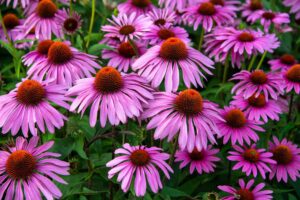
Benefits
Echinacea (commonly called coneflower) is one of the most researched medicinal plants in the U.S. and is especially valued for immune support:
-
Boosts immunity and helps the body fight colds, flu, and infections. A systematic review found echinacea preparations can reduce the risk of recurrent respiratory infections and slightly shorten colds. (nih.gov – NCCIH)
-
Contains antioxidant compounds (flavonoids, cichoric acid) that reduce inflammation and oxidative stress. (pubmed.ncbi.nlm.nih.gov)
-
May support wound healing and skin health when applied topically.
🌱 Planting & Maintenance (Ohio-Friendly)
| Step | Details |
|---|---|
| Planting Time | Sow seeds indoors 8–10 weeks before last frost (around March in Ohio), then transplant outside in late April–May. You can also plant nursery starts directly outdoors. |
| Soil & Light | Thrives in well-drained soil and full sun. Very drought-tolerant once established. |
| Watering | Water regularly during the first year until roots establish. After that, minimal watering is needed. |
| Timeline | Seeds may take 2–3 weeks to germinate. Plants bloom in their second year, but you can harvest leaves and roots earlier. |
| Maintenance | Hardy perennial in Ohio (USDA Zone 4–9). Cut back stems after frost; they regrow every spring. |
🍵 Easy Daily Remedy
Echinacea Tea for Immune Defense
-
Recipe: Steep 1–2 teaspoons of dried echinacea root or leaves in boiling water for 10 minutes. Drink at the first sign of a cold or during flu season.
-
Why It Works: Active compounds stimulate the immune system and may help your body fight off infections faster (NCCIH – NIH).
📊 Summary Table
| Feature | Echinacea Highlights |
|---|---|
| Benefits | Strengthens immunity, shortens colds, reduces inflammation |
| Planting | Indoors (early spring) → Transplant outdoors after frost |
| Sun Requirement | Full sun |
| Water Needs | Moderate (low once established) |
| Harvest Time | Roots/leaves harvestable after 1 year; blooms in year 2 |
| Lifespan | Perennial – regrows yearly in Ohio |
Echinacea is not only low-maintenance but also one of the most valuable medicinal herbs you can grow in Ohio—it practically thrives on neglect once established.
5. Calendula – The Skin Healer
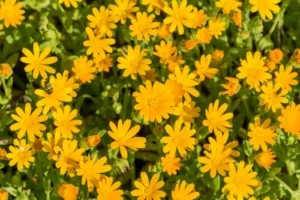
Benefits
Calendula (Calendula officinalis), also known as pot marigold, is famous for its skin-healing and anti-inflammatory properties.
- Wound Healing & Skin Health → Calendula creams and salves promote faster healing of minor wounds, cuts, and burns (PubMed).
- Anti-Inflammatory → Contains flavonoids and carotenoids, reducing swelling and irritation (NIH – NCCIH).
- Antimicrobial → Helps prevent infection in minor skin injuries.
- Often used in cosmetics for eczema, rashes, and dry skin.
🌱 Planting & Maintenance (Ohio-Friendly)
| Step | Details |
|---|---|
| Planting Time | Sow seeds directly outdoors in spring after last frost (late April–May in Ohio). Also grows well in containers. |
| Soil & Light | Prefers average, well-drained soil. Thrives in full sun, though it tolerates partial shade. |
| Watering | Moderate needs: water when soil feels dry; avoid overwatering. |
| Timeline | Germinates in 7–14 days. Blooms in 6–8 weeks and flowers throughout summer until frost. |
| Maintenance | Deadhead spent blooms to encourage continuous flowering. Self-seeds easily, so you’ll often get new plants next year without replanting. |
🧴 Easy Daily Remedy
Calendula Salve for Skin Healing
- Recipe:
- Dry calendula flowers and infuse them in olive oil for 2–3 weeks.
- Strain the oil and mix with melted beeswax.
- Store in a jar and use on cuts, scrapes, or dry skin.
- Why It Works: The flavonoids and triterpenoids in calendula accelerate wound healing and reduce inflammation (PubMed).
📊 Summary Table
| Feature | Calendula Highlights |
|---|---|
| Benefits | Wound healing, skin soothing, anti-inflammatory |
| Planting | Sow outdoors in spring (after frost) |
| Sun Requirement | Full sun to partial shade |
| Water Needs | Moderate |
| Timeline | Germination: 7–14 days; Blooms in 6–8 weeks |
| Lifespan | Annual (reseeds easily for next year) |
Calendula is a must-have for every Ohio garden—it adds bright color, requires minimal care, and provides one of the best natural remedies for skin health.
6. Lemon Balm – The Mood Lifter
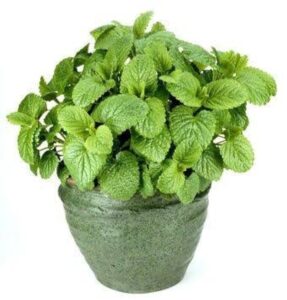
Benefits
Lemon Balm (Melissa officinalis) is a member of the mint family with a light lemon scent and powerful calming effects. Research shows:
- Reduces Anxiety & Stress → Studies show lemon balm extract significantly reduces anxiety and improves mood (PubMed).
- Supports Sleep → Helps improve sleep quality, especially when combined with other calming herbs like chamomile.
- Digestive Aid → Traditionally used for indigestion and bloating (NIH – NCCIH).
- Antiviral Effects → Has been studied for treating cold sores when applied topically.
🌱 Planting & Maintenance (Ohio-Friendly)
| Step | Details |
|---|---|
| Planting Time | Plant in spring after frost. Can be grown from seed, cuttings, or starter plants. |
| Soil & Light | Prefers rich, moist, well-drained soil. Grows in full sun to partial shade (thrives in Ohio summers with a bit of shade). |
| Watering | Keep soil consistently moist but not waterlogged. |
| Timeline | Seeds germinate in 7–14 days. Harvestable leaves in 2–3 months. |
| Maintenance | Perennial in Ohio (USDA zones 4–9). Cut back regularly to prevent flowering (which makes leaves less flavorful). Easy to grow in pots since it spreads aggressively. |
🍵 Easy Daily Remedy
Lemon Balm Tea for Stress Relief & Sleep
- Recipe: Steep 10–12 fresh leaves (or 1–2 teaspoons dried) in hot water for 10 minutes. Drink before bedtime or during stressful moments.
- Why It Works: Contains rosmarinic acid and flavonoids that reduce stress hormones and support relaxation (PubMed).
📊 Summary Table
| Feature | Lemon Balm Highlights |
|---|---|
| Benefits | Reduces stress & anxiety, improves sleep, aids digestion |
| Planting | Spring after frost |
| Sun Requirement | Full sun to partial shade |
| Water Needs | Consistently moist soil |
| Timeline | Germination: 7–14 days; Ready to harvest in 2–3 months |
| Lifespan | Perennial (regrows every year in Ohio) |
Lemon Balm is an easy, beginner-friendly plant that offers both calming benefits and a refreshing taste. It’s one of the best herbs for anyone looking to naturally support mental health and relaxation.
7. Thyme – The Natural Antiseptic
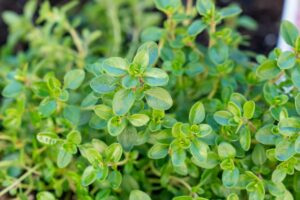
Benefits
Thyme (Thymus vulgaris) is more than a kitchen herb—it’s a medicinal powerhouse:
- Respiratory Health → Thyme extracts are used in cough syrups; studies show it helps reduce cough and bronchitis symptoms (PubMed).
- Antimicrobial Power → Contains thymol, a compound with natural antiseptic and antibacterial properties (NIH – PubChem).
- Anti-Inflammatory → Helps reduce inflammation and oxidative stress.
- Traditionally used to relieve sore throats, congestion, and infections.
🌱 Planting & Maintenance (Ohio-Friendly)
| Step | Details |
|---|---|
| Planting Time | Plant in spring after last frost. Can be grown from seed, cuttings, or starter plants. |
| Soil & Light | Prefers light, well-drained soil. Needs full sun (6–8 hours/day). |
| Watering | Low water needs—let soil dry between watering. Overwatering can cause root rot. |
| Timeline | Seeds germinate in 7–21 days. Harvest sprigs after 2–3 months of growth. |
| Maintenance | Hardy perennial in Ohio (zones 5–9). Cut back stems after winter; regrows every year. Compact plant, perfect for pots. |
🍵 Easy Daily Remedy
Thyme Tea for Sore Throat & Cough
- Recipe: Add 2 teaspoons of fresh or dried thyme leaves to hot water. Steep for 10 minutes. Strain and drink warm, with honey for added soothing effect.
- Why It Works: Thymol helps fight bacteria, while thyme’s natural compounds reduce inflammation in the throat and respiratory tract (PubMed).
📊 Summary Table
| Feature | Thyme Highlights |
|---|---|
| Benefits | Fights cough, sore throat, infections; antibacterial |
| Planting | Spring after frost; seeds, cuttings, or starter plants |
| Sun Requirement | Full sun (6–8 hrs/day) |
| Water Needs | Low; let soil dry between watering |
| Timeline | Germination: 7–21 days; harvest in 2–3 months |
| Lifespan | Perennial – hardy in Ohio |
Thyme is low-maintenance, winter-hardy, and perfect for beginners. Plus, it’s a natural remedy for colds and sore throats—something Ohioans can definitely use during the chilly winters.
8. Basil – The Anti-Inflammatory Herb
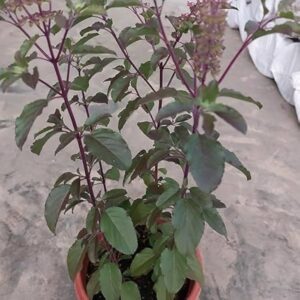
Benefits
Basil (Ocimum basilicum) is one of the most loved culinary herbs, but it also has powerful medicinal properties:
- Anti-Inflammatory & Antioxidant → Contains eugenol, linalool, and rosmarinic acid, which help reduce inflammation (PubMed).
- Supports Digestion → Traditionally used to ease bloating and indigestion.
- Immunity Booster → Basil has natural antimicrobial properties that help fight infections.
- Stress Relief → Compounds in basil help balance cortisol levels and support mental clarity (NIH – NCBI).
🌱 Planting & Maintenance (Ohio-Friendly)
| Step | Details |
|---|---|
| Planting Time | Start seeds indoors 6 weeks before last frost (March). Transplant outdoors in late spring (after May) when soil is warm. |
| Soil & Light | Needs rich, well-drained soil. Requires full sun (6–8 hrs/day). |
| Watering | Water deeply 1–2 times a week. Avoid letting soil completely dry out. |
| Timeline | Seeds germinate in 7–10 days. Harvestable leaves in 6–8 weeks. |
| Maintenance | Annual in Ohio. Pinch off flower buds to extend leaf production. Keep harvesting regularly to encourage bushy growth. |
🍵 Easy Daily Remedy
Basil Tea for Digestion & Inflammation
- Recipe: Steep 5–7 fresh basil leaves (or 1 teaspoon dried) in hot water for 10 minutes. Add honey if desired.
- Why It Works: Basil’s eugenol and rosmarinic acid reduce inflammation, while its natural oils aid digestion (PubMed).
📊 Summary Table
| Feature | Basil Highlights |
|---|---|
| Benefits | Reduces inflammation, aids digestion, boosts immunity |
| Planting | Indoors 6 weeks before frost → outdoors in May |
| Sun Requirement | Full sun (6–8 hrs/day) |
| Water Needs | Moderate; water weekly |
| Timeline | Germination: 7–10 days; harvest in 6–8 weeks |
| Lifespan | Annual (grow fresh each year in Ohio) |
Basil is one of the easiest herbs to grow at home and doubles as both a kitchen essential and a natural remedy. A true staple for any Ohio medicinal garden! 🌱
9. Feverfew – Nature’s Aspirin
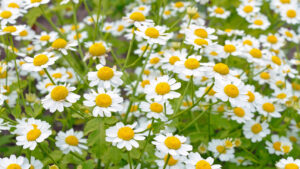
Benefits
Feverfew (Tanacetum parthenium) has been used for centuries for pain and inflammation relief, especially migraines:
- Migraine Prevention → Multiple studies confirm feverfew can reduce the frequency and intensity of migraines (Mayo Clinic).
- Anti-Inflammatory → Contains parthenolide, which helps reduce inflammation and ease arthritis pain (PubMed).
- Fever & Pain Relief → Traditionally used for reducing fevers, muscle tension, and general aches.
🌱 Planting & Maintenance (Ohio-Friendly)
| Step | Details |
|---|---|
| Planting Time | Direct sow outdoors in spring after last frost (April–May in Ohio). Can also start indoors 4–6 weeks earlier. |
| Soil & Light | Grows best in well-drained soil and full sun, but tolerates partial shade. |
| Watering | Moderate needs: water once or twice a week. Drought-tolerant once established. |
| Timeline | Germination in 10–14 days. Flowers appear in 8–10 weeks. |
| Maintenance | Perennial in Ohio (zones 5–9). Cut stems in fall; plant regrows in spring. Deadhead flowers to encourage more blooms. |
🍵 Easy Daily Remedy
Feverfew Tea for Migraine Relief
- Recipe: Steep 1 teaspoon dried feverfew leaves (or 2–3 fresh leaves) in hot water for 5–10 minutes. Strain and sip slowly.
- Why It Works: Feverfew’s parthenolide compound helps prevent the release of chemicals that trigger migraine inflammation (Mayo Clinic).
⚠️ Note: Feverfew is best used for prevention, not immediate migraine relief, and should not be consumed in large quantities. Not recommended for pregnant women.
📊 Summary Table
| Feature | Feverfew Highlights |
|---|---|
| Benefits | Prevents migraines, reduces inflammation & pain |
| Planting | Sow outdoors in spring after frost |
| Sun Requirement | Full sun to partial shade |
| Water Needs | Moderate; drought-tolerant once mature |
| Timeline | Germination: 10–14 days; flowers in 8–10 weeks |
| Lifespan | Perennial (comes back yearly in Ohio) |
Feverfew is a low-maintenance, hardy plant that rewards you with long-term health benefits, especially if migraines or inflammation are common concerns.
10. Aloe Vera – The Skin Soother
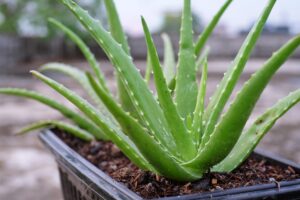
🌿 Proven Benefits
Aloe vera (Aloe barbadensis miller) is famous for its skin-healing and soothing properties, but it has wider benefits too:
- Burn & Wound Healing → Aloe gel accelerates healing of burns, cuts, and skin irritations (NIH – NCCIH).
- Skin Hydration → Natural moisturizer used in creams and lotions.
- Digestive Aid → Aloe latex (from beneath the skin) has laxative effects, but should be used with caution.
- Anti-Inflammatory → Contains antioxidants like polyphenols that fight inflammation.
🌱 Planting & Maintenance (Ohio-Friendly)
| Step | Details |
|---|---|
| Planting Time | Grows best as a potted plant indoors in Ohio. Can be moved outdoors in summer but must be brought inside before frost. |
| Soil & Light | Requires well-drained, sandy soil (cactus/succulent mix works well). Needs bright, indirect sunlight indoors or partial sun outdoors. |
| Watering | Very low water needs. Water only when the soil is completely dry (every 2–3 weeks). Overwatering is the main cause of death. |
| Timeline | Slow grower. Takes 2–3 years to mature, but leaves can be harvested earlier once the plant is established. |
| Maintenance | Minimal care—just avoid frost and overwatering. Repot every 2–3 years if roots crowd the pot. |
🧴 Easy Daily Remedy
Fresh Aloe Gel for Burns & Skin Care
- Recipe: Cut an aloe vera leaf, slice it open, and scoop out the clear gel. Apply directly to burns, cuts, rashes, or dry skin.
- Why It Works: Aloe contains glucomannan and gibberellins, which stimulate collagen production and accelerate wound healing (NIH – NCCIH).
📊 Summary Table
| Feature | Aloe Vera Highlights |
|---|---|
| Benefits | Heals burns & wounds, hydrates skin, reduces inflammation |
| Planting | Best grown in pots indoors in Ohio |
| Sun Requirement | Bright indirect sunlight |
| Water Needs | Low; water only when soil is dry |
| Timeline | 2–3 years to full maturity |
| Lifespan | Perennial (lives many years with proper care) |
Aloe vera is a must-have medicinal plant for any Ohio home—it requires almost no effort, looks beautiful indoors, and provides instant first-aid for burns and skin problems.
✅ That completes the full list of 10 medicinal herbs for Ohio with benefits, planting tips, timelines, and remedies.
Final Thoughts: Start Your Backyard Pharmacy in Ohio 🌱
As you’ve seen, Ohio’s climate makes it possible to grow a wide range of medicinal herbs right at home—from calming chamomile and stress-relieving lavender to immunity-boosting echinacea and skin-soothing aloe vera. These plants don’t just add greenery to your home; they give you a natural pharmacy at your fingertips.
Imagine sipping on a cup of lemon balm tea after a stressful day, rubbing fresh aloe gel on a burn, or making your own calendula salve for cuts and scrapes. These remedies are simple, effective, and proven by centuries of use—now made possible in your own garden, balcony, or windowsill.
The best part? You don’t need to be a gardening expert. With just a little sunlight, the right soil, and a few minutes of care each week, you can grow your way to better health.
🌿 Want to Skip the Guesswork?
If you’d like an easy way to get started, the Medicinal Garden Kit has everything you need:
✅ 10 packs of heirloom, non-GMO seeds (including chamomile, calendula, echinacea, feverfew, and more).
✅ A step-by-step guidebook with 65+ recipes for teas, tinctures, salves, and remedies.
✅ Bonus resources on foraging and natural healing.
✅ Seeds selected to grow in all U.S. climates—including Ohio.
👉 Click here to get your Medicinal Garden Kit today and start building your very own backyard pharmacy.
Because when it comes to health, the best remedies aren’t always found in a bottle—they’re often growing right outside your door. 🌸
